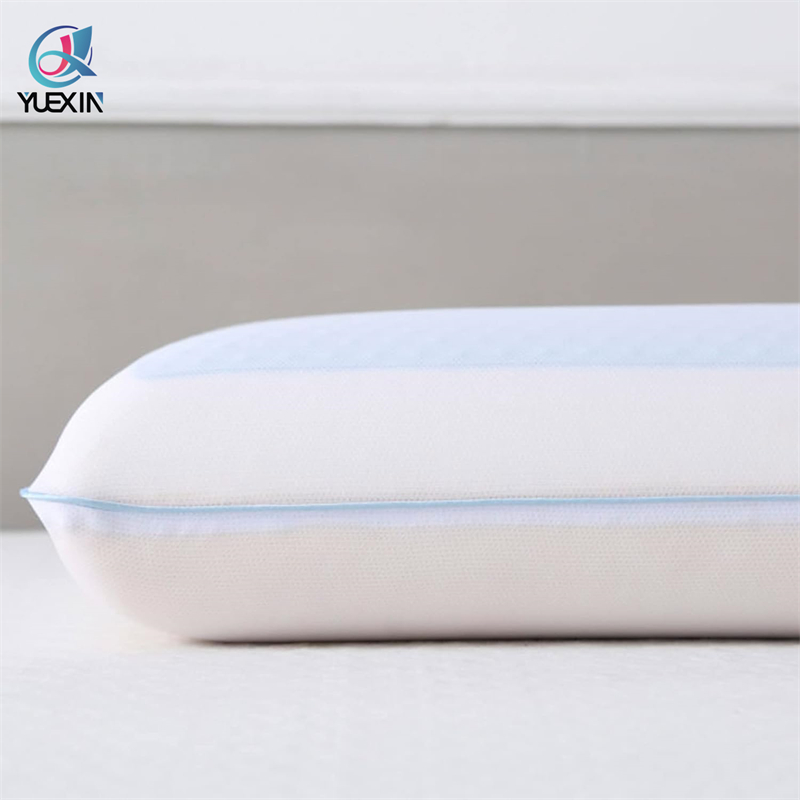Views: 0 Author: Site Editor Publish Time: 2025-07-15 Origin: Site









Are you getting the best sleep with yourmemory foam pillow? The right pillow can change your sleep quality. Memory foam pillows contour to your body, offering great support and comfort. However, your sleeping position plays a huge role in how effective the pillow is. In this post, we’ll discuss the best positions to sleep on a memory foam pillow and how they impact your spine alignment and muscle relaxation.

Memory foam pillows are unique compared to traditional pillows. Let’s break down what sets them apart and why they might be the best option for you.
Memory foam is a viscoelastic material. It responds to heat and pressure, molding to the shape of your head and neck. This ability to adapt helps relieve pressure points, offering tailored support for better sleep.

Contours to your head and neck: Memory foam perfectly adapts to your body shape, offering personalized support.
Pressure relief: It evenly distributes weight across the pillow, reducing discomfort and strain.
Spine alignment: It helps maintain a neutral spine position, especially for side and back sleepers, reducing neck and back pain.
Memory foam pillows come in different styles to suit various sleep needs:
Contoured Pillows: These pillows have a dip in the center, providing extra support for your neck and aligning the spine.
Traditional Memory Foam Pillows: A versatile option, suitable for all sleeping positions. It offers medium to firm support.
Gel-Infused Pillows: Infused with gel particles, these pillows stay cooler, making them ideal for hot sleepers.
Shredded Memory Foam Pillows: These offer flexibility and adjustability, perfect for stomach sleepers or those who frequently change positions during the night.
Your sleeping position plays a crucial role in how effectively a memory foam pillow supports you. Let’s dive into the best practices for side sleepers and how to make sure your pillow works for you.
Side sleeping is one of the most common sleeping positions. Memory foam pillows are especially good for side sleepers because they provide the right support for the neck and spine.
Aligns the spine: Memory foam’s ability to contour to your body keeps your spine aligned, which helps alleviate neck and back pain. By maintaining a neutral alignment, it reduces unnecessary pressure on the spine.
Supports head and neck: The pillow offers continuous support to your head and neck without causing muscle strain. This ensures comfort throughout the night, allowing for a more restful sleep.
Firmness and height: It’s essential to choose a pillow that provides the right level of firmness and height for your body. This allows the pillow to properly support your neck, keeping your spine aligned and reducing the risk of waking up with stiffness or pain.
Contoured pillows: For side sleepers, contoured pillows are ideal. They feature raised sides that provide additional neck support, helping to maintain spinal alignment. This design also reduces strain on the shoulders and hips, offering more comfort during sleep.
Fill the gap: Ensure the pillow fills the space between your head and shoulder to keep your neck straight. This prevents awkward positioning that can lead to pain or stiffness.
Chin position: Keep your chin aligned with the rest of your body and avoid tucking it in. Tucking your chin can strain the neck muscles, leading to discomfort the next morning.
Pressure point relief: Memory foam pillows are great at relieving pressure points, especially around the shoulders. The material evenly distributes weight, reducing pressure and ensuring a more comfortable sleep experience.
Back sleeping offers great benefits for spinal alignment when paired with the right memory foam pillow.
Aligns the head and neck: Sleeping on your back naturally supports your head and neck, promoting proper spinal alignment. This helps reduce the chances of waking up with neck stiffness or discomfort.
Improves spinal health: Memory foam’s ability to contour to your neck and head provides the necessary support, cradling the neck gently. This helps to reduce strain, ensuring better spinal health and preventing neck pain over time.
Medium firmness: For back sleepers, a medium-firm pillow provides the right balance of support. It keeps the head, neck, and spine aligned without pushing the head too far forward or leaving it too low.
Cervical dip: Some memory foam pillows are designed with a dip to support the natural curve of your neck. This feature ensures better alignment and provides targeted support for your cervical spine, helping to reduce neck strain.
Position the pillow under the neck: Ensure the pillow is placed under your neck to support the cervical curve, preventing any unnatural angle or strain.
Align your head with the spine: Make sure your head is aligned with your spine. Avoid pushing the head too far forward or tilting it back, as this could cause discomfort or misalignment.
Firmness matters: A medium-firm pillow is ideal for back sleepers. It provides just the right amount of support, ensuring comfort without being too soft or too firm, which can cause strain and lead to neck pain.
Stomach sleeping presents a few challenges when using a memory foam pillow. While it can be cozy, it may not always be the best position for spinal health.
High neck strain: Stomach sleeping can cause significant neck strain as it forces your neck to twist to one side. This unnatural position leads to discomfort and stiffness, making it harder to get a restful sleep.
Poor spinal alignment: Sleeping on your stomach often results in poor spinal alignment. This misalignment can put extra pressure on your lower back, leading to long-term pain and discomfort.
Thinner, softer pillow: A thinner and softer pillow helps prevent the head from being elevated too high, reducing strain on the neck. It also minimizes the risk of neck misalignment.
Shredded memory foam pillows: These pillows offer more flexibility and adjustability. They can be molded to fit the shape of your neck and head, providing customized support and comfort for stomach sleepers.
Place the pillow under your chest or head: To alleviate pressure, place the pillow either under your chest or head. This helps keep the spine in a more neutral position, reducing strain on the neck.
Avoid using a thick pillow: Thick pillows raise the head too much, causing misalignment. A thinner pillow is crucial for reducing neck strain and helping keep the spine straight.
Spinal alignment: Focus on keeping your body as flat as possible while sleeping. A flat body position reduces the risk of discomfort and helps maintain proper spinal alignment throughout the night.
Finding the right pillow can be tricky, especially when your sleeping position plays a key role in your comfort. Let’s break down the best pillow choices based on whether you sleep on your side, back, or stomach.

Side sleepers need a pillow that provides proper support for the head and neck, keeping them aligned with the spine. This helps prevent muscle strain and discomfort during the night.
Look for high loft and firm support: A pillow with a high loft and firm support will fill the gap between the head and shoulder, ensuring that the spine stays aligned. This prevents the neck from bending at an awkward angle, which can cause pain and stiffness in the morning.
Contoured pillows are ideal: A contoured pillow is designed with raised sides to provide extra support for the neck. This helps maintain proper spinal alignment and reduces strain on the shoulders, offering greater comfort and support throughout the night.
Back sleepers require a pillow that offers balanced support to maintain proper spinal alignment. Since back sleeping is considered one of the best positions for spinal health, it’s important to select a pillow that helps keep the head, neck, and spine aligned.
Medium firmness with a cervical dip: A pillow with medium firmness provides balanced support without being too stiff or too soft. The cervical dip in the pillow cradles the neck’s natural curve, providing targeted support for the cervical spine. This alignment helps reduce neck and back pain and ensures you wake up feeling refreshed.
Ensure spinal alignment: The pillow should keep the head in a neutral position, neither tilting too far forward nor backward. Proper spinal alignment is key to preventing discomfort, ensuring the neck is properly supported, and minimizing the risk of waking up with pain.
Stomach sleepers face unique challenges when selecting a pillow. This sleeping position can cause strain on the neck and spine, so choosing the right pillow is essential to reduce discomfort.
Opt for low loft and soft materials: A thinner and softer pillow is essential for stomach sleepers. It prevents the head from being raised too high, which can put unnecessary pressure on the neck. The lower loft helps keep the head closer to the mattress, maintaining better spinal alignment.
Look for soft memory foam: Soft memory foam is more flexible, allowing the pillow to conform to the natural shape of your neck. This provides better comfort and flexibility, keeping your neck in a more neutral position, reducing strain and improving overall comfort while sleeping on your stomach.
Memory foam pillows offer great support, but they might feel different from regular pillows. Here are some tips to help you get the most comfort out of your memory foam pillow.
Memory foam can take a bit of time to mold to your body. Here’s how to get comfortable:
Give it time to adjust to your body heat: Memory foam softens and molds to your head and neck over time. Give it a few minutes to adapt to your body temperature for maximum comfort.
Fluffing the pillow: If the pillow feels too flat or too firm, fluff it up or adjust the layers. You can also flatten it to make it softer, depending on your preference.
Why some memory foam pillows can get hot: The material tends to trap heat, which can make the pillow feel warmer than usual.
How to keep cool at night:
Use cooling pillowcases made from moisture-wicking fabrics to keep you cool.
Consider gel-infused memory foam pillows, which help regulate heat.
Considerations: Make sure the room has proper air circulation to prevent the pillow from absorbing too much heat.
Taking care of your memory foam pillow will extend its lifespan and keep it comfortable.
Some memory foam pillows can retain heat, but here’s how to keep cool at night:
How to take care of your memory foam pillow:
Spot clean with a mild detergent and air dry it completely to keep it fresh.
Regularly air out the pillow to remove moisture and heat buildup.
Use a pillow protector to reduce allergens and stains.
Considerations: Avoid machine washing or drying your pillow to maintain its shape and support.
Choosing the right pillow for your sleeping position is crucial for comfort and health. Memory foam pillows help reduce neck and back pain by providing proper support. Experiment with different positions and adjust your pillow to find the best comfort for a restful night’s sleep.
A: Sleeping in the wrong position can cause neck, back, and shoulder pain due to misalignment. Proper alignment of the spine and neck is essential for comfort and preventing discomfort.
A: Yes, using a memory foam pillow in the correct position can help open the airways, reducing snoring. This is especially beneficial for people with sleep apnea or other breathing issues.
A: Alternatives include latex pillows, down pillows, or buckwheat pillows. Memory foam may not suit those with allergies or those who prefer firmer support.
Ready to upgrade your sleep? Try the best memory foam pillows for your sleeping position today.
Explore more on how to improve your sleep health: Check out other articles on sleep hygiene and pillow care.